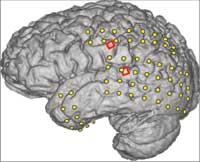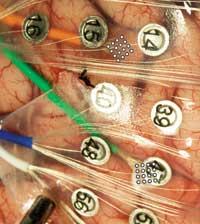Brain signals

Two years ago, researchers from Boston University presented an experiment in which, through a voice synthesizer, they managed to say vowels designed by a person with muscle disabilities. Until then, most of these studies focused on the union of the brain and movement, which was probably the first to be done with language.
The news that has now come to us from the University of Utah, however, may be said to have somehow abandoned that research in Boston. In fact, beyond the vowels, they have developed a method capable of writing words thought by a person on a computer. Some people with severe paralysis have defined as “serious first step” on the path of speaking through thoughts. The news was published by the scientific journal Journal of Neural Engineering.
Ten words
Researchers installed a man two networks of 16 microelectrodes (button size) in areas related to brain language. The volunteer has severe epilepsy seizures after a previous craniotomy (temporary removal of part of the skull). Thus, doctors had the opportunity to place electrodes to locate the origin of the attacks and surgically interrupt them.

The image shows two types of electrodes. For example, the two networks of 16 microelectrodes used in research are of actual size of a button. (Photo: University of Utah.
The electrodes were placed under the skull and above the brain. “But without penetrating the brain,” the researchers explain. And they wanted to avoid any possibility of irreversible damage.
The patient was told to read ten words over and over again. And, using experimental microelectrodes, whenever he read each of those words, they recorded the signals that his brain sent. The selected words were: yes, no heat, cold, hunger, thirst, hello, agur, more and less .
Later, we tried to find out what signal the brain emits to represent each word. When the volunteer wanted to say “yes” and “no”, for example, they compared the two signals sent by his brain. It is explained that between 76 and 90% of cases were able to correctly interpret each signal.
When observing the patterns of the ten signals at once, inventions ranged from 28% to 40%; the result is four times better than that obtained by random procedure (10% would be random). “But it is not enough for a device that transfers the thoughts of a paralyzed person by computer,” the head of the study acknowledged.

(Photo: Spencer Kellis, University of Utah.
“This is a conceptual test,” he adds. We have found that brain signals can tell us that someone is thinking, going far beyond chance. We are clear, but before we become really useful, we will have to be able to create more words and more accurately.”
The “reading of thought” method can help people suffering from cerebral spill paralysis, Lou Incrementam, or severe trauma. Regarding the weak movements of the gestures or hands of the eyes, it would be a great advance in terms of their autonomy.
Surely, yes, the road will continue. The procedure needs to be greatly improved and adjusted first. This is, for the moment, the priority of researchers.
Published in Ortzadar.
Buletina
Bidali zure helbide elektronikoa eta jaso asteroko buletina zure sarrera-ontzian











